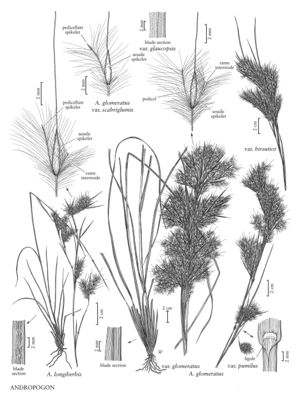familyPoaceae
subfamilyPoaceae subfam. Panicoideae
genusAndropogon
sectionAndropogon sect. Leptopogon
speciesAndropogon glomeratus
Difference between revisions of "Andropogon glomeratus var. hirsutior"
Treatment appears in FNA Volume 25. Treatment on page 664.
FNA>Volume Importer |
imported>Volume Importer |
||
| Line 38: | Line 38: | ||
|publication year= | |publication year= | ||
|special status= | |special status= | ||
| − | |source xml=https:// | + | |source xml=https://bibilujan@bitbucket.org/aafc-mbb/fna-data-curation.git/src/bb6b7e3a7de7d3b7888a1ad48c7fd8f5c722d8d6/coarse_grained_fna_xml/V25/V25_1597.xml |
|subfamily=Poaceae subfam. Panicoideae | |subfamily=Poaceae subfam. Panicoideae | ||
|tribe=Poaceae tribe Andropogoneae | |tribe=Poaceae tribe Andropogoneae | ||
Revision as of 22:02, 27 May 2020
Plants usually oblong in the upper portion, sometimes cylindrical. Culms 1-2 m; internodes not glaucous. Sheaths scabrous; ligules ciliate or not, cilia to 0.3 mm; blades green, usually pubescent. Subtending sheaths of inflorescence units (2)2.4-3.1(4) mm wide; peduncles 2-5(8) mm; rames usually 1.7-2.8 cm, not exserted at maturity. Keels of lower glumes usually smooth below midlength, scabrous distally; anthers often retained within the spikelets.
Distribution
Va., Okla., Miss., Tex., La., Ark., N.J., Ala., Tenn., Ga., Ky., Fla., Md., N.C., S.C.
Discussion
Andropogon glomeratus var. hirsutior grows in ditches, swales, bogs, flatwoods, and savannahs of the southeastern coastal plain, often forming very large populations in cleared, low ground.
Selected References
None.
Lower Taxa
None.
... more about "Andropogon glomeratus var. hirsutior"
